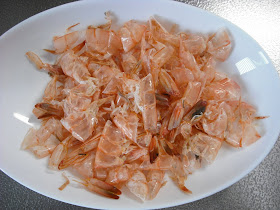エビマヨも日本では人気のある中華料理です。私は周富徳さんのレシピーでこの料理を作りたいと思いました。
Reference (Japanese only)/参考(日本語のみ):
Shu Tomitoku's Ebi Mayo Recipe/周富徳さんの海老マヨレシピ
Ingredients (4 servings)
12 shrimp
Some salt and sake with which to rub shrimp
*Some salt and pepper
*Potato starch (katakuriko) to coat the shrimp
*Some sesame seed oil
*1/2 egg white
**1 cup mayonnaise
**3 tbsp ketchup
**3 tbsp condensed milk
**2 tbsp evaporated milk
**2 tsp gin
**Some salt and finely chopped parsley
Coarsely chopped cashew nuts
材料(4人分)
海老12尾
海老をもむのに使う塩とお酒少々
*塩コショウ適量
*片栗粉 まぶす程度
*ごま油少々
*卵白1/2個
**マヨネーズ 1カップ
**ケチャップ 大3
**コンデンスミルク 大3
**エバミルク 大2
**ジン 小2
**塩&パセリみじん切り 少々
Directions:
1. Devein shrimp, rub with salt and sake, and rinse with water.
2. Mix with the ingredients preceded by an asterisk (*).
3. Make a cut in the back of each shrimp, open the shrimp, and roll in firmly from the tail to the head, with the back inside.
(NOTE: I don't understand the original Japanese. The above English is a literal translation of the Japanese.)
4. Mix together all the ingredients preceded by two asterisks (**).
5. Coat the shrimp with potato starch, deep-fry in oil at 180C or higher.
6. Mix with the ingredients in 4. while the shrimp are still hot.
7. Sprinkle coarsely chopped cashew nuts.
作り方:
1. 背ワタを取って、塩、酒でもみ、水で洗う。
2.*で示した材料を混ぜる。
3.エビの背に包丁を入れ、開き背を内側にして尾から頭に向けて、しっかり巻き込む。
4.**で示した材料も混ぜる。
5.エビに片栗粉をまぶして、180度以上の油で揚げる。
6.熱いうちに4.の材料とまぜる。
7.粗みじん切りしたカシューナッツを振りかける。
I didn't follow the recipe exactly: I didn't rub the shrimp with salt and sake, I didn't devein the shrimp, I didn't follow step 3 because I wasn't sure what the step meant, I replaced evaporated milk with milk, I reduced the amount of mayonnaise to a half, as well as the other ingredients marked with two asterisks, etc., etc.
私はこのレシピーを正確には従いませんでした。海老を塩と酒でもまず、海老の背わたはとらず、3は省き(何を言っているのかよく分からないので)、エバミルクはミルクで代用し、マヨネーズは半分に減らし、残りの**で示した材料も半分にしました、などなど。
According to other sites, the condensed milk keeps the mayonnaise from separation.
別のサイトによると、コンデンスミルクはマヨネーズの分離を防ぐそうです。
I shelled the shrimp, removed the tails from them, dried the tails and shells in the microwave, and ground them in my Milser (a small blender). I later added some white sesame seeds and some salt. Simple furikake was made!
海老の皮をとり、尾もとり、尾と皮を電子レンジで乾燥させ、ミルサー(小さなミキサー)で挽きました。後で白胡麻と塩を少し足しました。簡単なふりかけができました!



Confession: My first attempt was not a success: I overcooked the shrimp. Considering the high fat content of this dish, I don't think I'll make another try. My wife said she preferred ebi chili because it was spicy. I agree with her on this point.
告白: 初めての試みは成功しませんでした。海老に火を通し過ぎました。
この料理は脂肪分が多いので、もう一回作ろうとは思いません。
妻は、エビチリのほうが辛いので好きだと言いました。私も賛成です。
Edited to add this photo on March 8:
3月8日にこの写真を追加:

For lunch today, I had the leftover ebi mayo with a slice of toasted bread, mizuna (a type of green), and the furikake that I made last night. It wasn't bad.
今日の昼食には、残りのエビマヨをトーストしたパン、水菜、昨晩作ったふりかけと一緒に食べました。悪くはないです。
About step 3 ... could it be an instruction to butterfly the prawns? Cut down the length of the back into the body of the prawn but not through to the "belly". Then open out and flatten.
ReplyDeleteChee Fai: Thanks! I don't know much about Chinese cuisine. Butterfly the prawns! Learning new things every day! I really wasn't sure what "makikomu" (lit. to "roll in") could mean...
ReplyDeleteThe translation isn't too clear, but if you couldn't work it out from the original Japanese then I don't think they were very good instructions. It is a logical step after deveining.
ReplyDeleteThe 2-star ingredients look like those for a "prawn cocktail" (or Marie Rose) sauce. You could probably leave out the milk ingredients. Some recipes add brandy instead of gin (or not at all). Some have tabasco. Some garnish the prawns with paprika (smoked would be good). Just some ideas ... I enjoy your blog.
ReplyDeleteChee Fai: Thanks again! Logical step? Hmm... That sounds interesting. When I use cultured prawns, I simply use a bamboo stick to devein them. I once used wild prawns, and I had to make a cut along the back of each to remove a large amount of vein.
ReplyDeleteThanks for comment about the similarity to prawn cocktail. That didn't occur to me!
I don't know why, but a combination of mayonnaise and ketchup is called aurora sauce
オーロラソース
in Japan.
The reason why I wanted to follow Shu's recipe is that it is highly spoken of by many Japanese people. Some say that gin and condensed milk are the key. As I said in the post, condensed milk keeps the mayo from separation, and is a required ingredient because the sauce is mixed with deep-fried shrimp while they are still hot.
Prawn cocktail sounds very interesting, and it's certainly less fatty than ebi mayo. I will post about it when I make it.
This recipe is somewhat similar to Honey Walnut Shrimp found in many Chinese restaurants in the US. I heard it originated from Hong Kong.
ReplyDeleteRinshinnomori: I have decided not to try this recipe again. For one thing, my children didn't like it, and it's just too fatty for another. I think I'll stick to ebi chili.
ReplyDelete